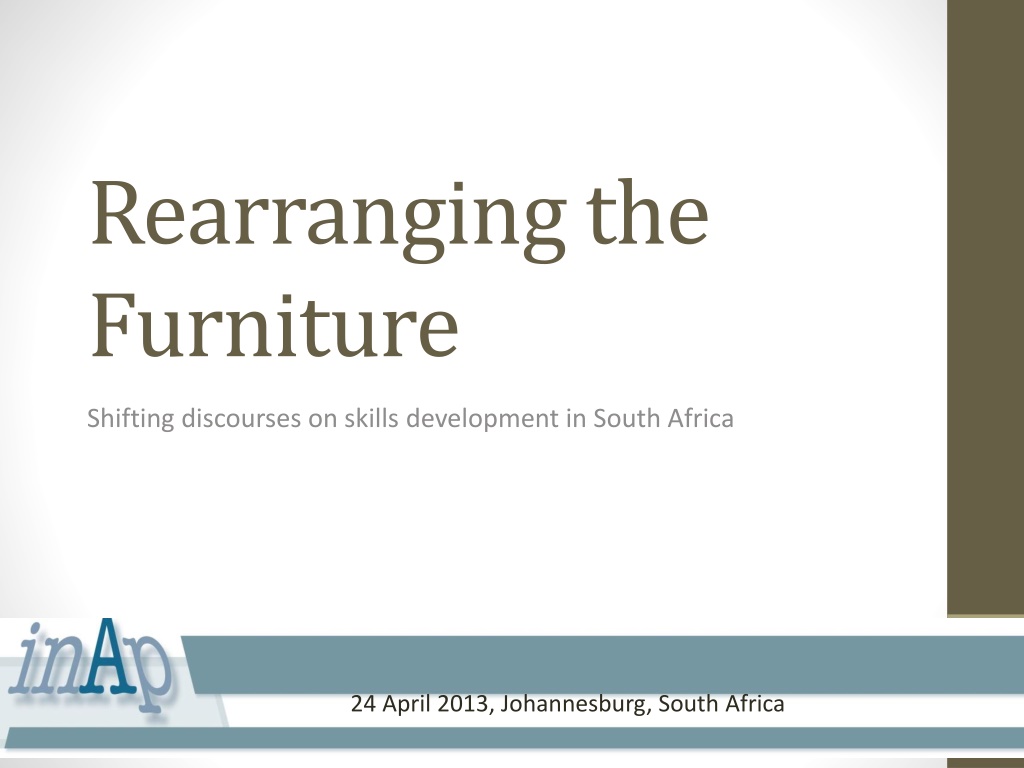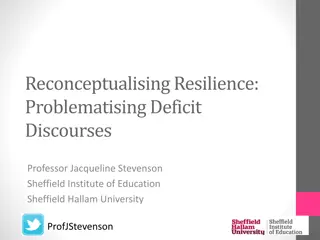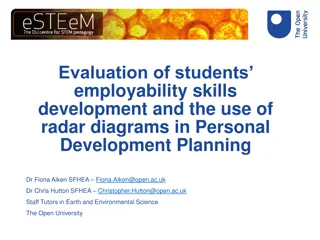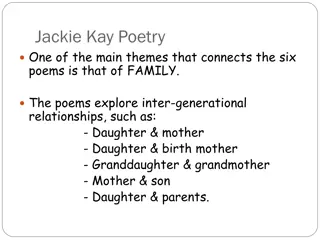Understanding Historical Context in Skills Development Discourses
Exploring the evolution of apprenticeship and skills development through historical sociology, historical futures, modes of justification, and complexity concepts. Emphasizing the importance of nuanced historical understanding to navigate contemporary challenges in South Africa's skills development landscape.
Download Presentation

Please find below an Image/Link to download the presentation.
The content on the website is provided AS IS for your information and personal use only. It may not be sold, licensed, or shared on other websites without obtaining consent from the author. Download presentation by click this link. If you encounter any issues during the download, it is possible that the publisher has removed the file from their server.
E N D
Presentation Transcript
Rearranging the Furniture Shifting discourses on skills development in South Africa 24 April 2013, Johannesburg, South Africa
Introduction The apprenticeship was born hundreds of years ago (the Middle Ages) in other countries, when young people worked under a master craftsman to learn trades. This was a form of inexpensive work in exchange for learning and the young men often lived in the craftsmen s houses. Women were taught in embroidery and silk-weaving. (Department of Labour pamphlet - undated) What is missing from this account? I argue that in order to understand the discourses of apprenticeship and skills development we need a more nuanced account of where we have come from in order to better compare, and understand where we are going.
Historical Sociology Drawing on the work of Norbert Elias (1897-1990) Contemporary issues are an outcome of historical processes Particular forms of social life are the unintended outcome of social processes, which may or may not have been planned. We need to understand both historical continuity as well as the ruptures, breaks and spurts that occur in the formation of societies (1996). Where there is a break at one level, not all dimensions and levels of social life change in neat correspondence, and there is a need to understand historically the residual forms of social life when society appears to have changed. This is particularly important for making sense of social relations in a society where over three hundred years of colonial conquest, racial privilege, and patriarchal power relations lie beneath the veneer of rapid social change.
Historical Futures Green (2012) Refers to the future imagined by historical actors Shifts focus from understanding how the past unfolded to what people imagined the future would be
Modes of Justification Boltanski and Th venot (1999) Social life can be analysed in terms of justifications for action, that is the criteria used to justify actions. Since there can be a plurality of modes of justification, and that these modes can be mutually incompatible, it is necessary to understand which rules are being invoked and which are applied. Different modes (or discourses) of justification may be invoked at different points by different people around the same set of practices.
Complexity Ramalingam and Jones (2008) Draws on understandings of processes and dynamics of change in physical and biological world Applied to social systems Key Concepts Interconnected and interdependent elements and dimensions; Feedback processes; System characteristics and behaviours emerge from simple rules of interaction; Nonlinearity; Sensitivity to initial conditions; Phase space the space of the possible ; Attractors, chaos and the edge of chaos ; Adaptive agents; Self-organisation; Co-evolution. In our view, the value of complexity concepts are at a meta-level, in that they suggest new ways to think about problems and new questions that should be posed and answered, rather than specific concrete steps that should be taken as a result. (p.68)
Early forms of apprenticeship Apprenticeship in South Africa linked directly to the system of slavery, rather than being an importation of the middle ages European tradition. The Dutch traders and early settlers imported slaves to carry out semi-skilled and skilled artisanal labour in the towns and farms that developed in Southern Africa after 1652 In 1775 the concept of apprenticeship was introduced to allow slave owners to apprentice the children of male slaves and free Khoisan or Hottentot women till their 25th year. As labour pressures increased, this practice was extended to any Hottentot child . These practices were abolished in the late 1790s, but reintroduced with respect to free coloured children between the age of 8 and 18 if they were deemed to be destitute, orphaned or simply if they had grown up on the employer s farm
Emancipation When the British Empire abolished slavery in 1834, apprenticeship was the mechanism through which this change was managed. In order to deal with the transition from a slave based labour system to a market based system, slaves were first indentured to their former owners, and could be retained as apprentices for a period of four years, before they were freed.
Race and labour "We should not give the Natives any academic education. If we do, who is going to do the manual labour in the community?" JN le Roux, National Party politician, 1945. "There is no place for [the Bantu] in the European community above the level of certain forms of labour ... What is the use of teaching the Bantu child mathematics when it cannot use it in practice? That is quite absurd. Education must train people in accordance with their opportunities in life, according to the sphere in which they live." Dr Hendrik Verwoerd, South African minister for native affairs (prime minister from 1958 to 66), speaking about his government's education policies in the 1950s.
The Taboo on Manual Labour I do garden work. I do repairs around the house. I am at present relaying the drainage. It may seem funny to you but to me it is not a joke. I am making a gesture. I am trying to break the taboo on manual labour. The taboo? Yes. Just as in India it is a taboo for upper-caste people to clean up what shall we call it? human waste, so, in this country, if a white man touches a pickaxe or a spade he at once becomes unclean. From Summertime by J.M. Coetzee (2010 pp.112)
Resistance "We shall reject the whole system of Bantu Education whose aim is to reduce us, mentally and physically, into 'hewers of wood and drawers of water'." Soweto Students Representative Council, 1976.
Job Reservation Political pressure and extensive industrial action on the part of the white workers in the first two decades of the twentieth century resulted in a complex system of classification that linked certain types of work to certain racial categories. Essentially the more skilled and better paid work was reserved for whites. This is best illustrated by the Juvenile Affairs Act of 1921 and the Apprenticeship Act of 1922 which set up mechanisms for the placement of white youth in employment and put the minimum requirements for entry into apprenticeships out of the reach of the majority of coloured youths.
State Social Engineering The Apartheid state was used as a vehicle to uplift poor whites through affirmative action. State enterprises were key to providing employment and training. By the mid 1970s the economy had stalled and the resistance to apartheid was increasing. The state response was to open up skilled trades to black South Africans and build a black middle class
Summary 1 There is a complex relationship between race and manual labour that both stigmatises manual labour and excludes people from specific categories of skilled labour Four standout features need to be noted: apprenticeship has on numerous levels been exploitative and a form of modern slavery; apprenticeship has been used as a vehicle for social engineering; apprenticeships have been associated with a limited set of (primarily technical) trades and occupations; and technical occupations have tended to be viewed as being on lower levels of the status ladder in comparison with white collar work.
What is understood by an Apprenticeship?
Inheritance Since the mid 1980s the system of work-based or dual apprenticeship had gone into serious decline, both in terms of quality and quantity.
Post 1994 Major policy focus on education Integration, democratisation and economic development Policy borrowing, indiginisation and aid Focus on reorganisation of system Focus on changes in curriculum Led by the National Qualifications Framework
Imagined Future NQF the basis for an integrated system Bias toward academic education would be removed Colleges and vocationally oriented universities would expand High skills, high employment society would emerge
The National Qualifications Framework Higher Education Universities of Technology Private Providers Universities HEQC NSC FETC (now NCV) Grades 10-12 in Schools Further Education and Training FET Colleges Workplace Umalusi GEC ABET Certificates Schools Grade R 9 General Education and Training ABET Levels 1 4
Apprenticeships? Skills Development Act No. 97 of 1998 Because of the limitations identified in the apprenticeship system, a new concept of a learnership was introduced which catered not just for artisans but all occupations. Learnerships were designed to be modular so that they could be delivered through a range of modes of delivery, in colleges or on the job, and the work-based experience could be built up cumulatively in a number of different companies rather than through the traditional apprenticeship contract with one employer. To manage and fund this system, Sector Education and Training Authorities (SETAs) were established and funded through a training and skills development payroll levy system that made significant sums of money available. In 2000 the then Minister of Labour established a Working Group to oversee the phasing out of the old apprenticeship system in favour of learnerships.
Scripts, sequencing, silos and suspicions The imagined system was a complex unity, with different components supporting and linking to each other. In reality these components of the system were either differently able, unwilling or non-existent. As each component of the system evolved within the policy frame, increasing disjunctures, often based on incompatible modes of justification, appeared: Public understandings were uneven (nostalgia for the past) Contests emerged between different players in the state Mandates overlap Assumptions about other parts of the system were misplaced eg general education poor; institutional capacity uneven Curricula were not in place Business and labour do not always come to the party Low levels of trust
Back to the future? Back to the past? Grade 12 becomes the de facto exit point from schooling NATED curricula are reactivated Apprenticeships for artisans are not phased out and actively resuscitated How do we move forward in a complex world where the future signals Jobless growth Unstable markets A growing precariat (Standing 2012) Workplaces are not always available The nature of work is changing rapidly
DBE exam participation, pass and exemption rates 700,000 100.00% 90.00% 600,000 80.00% 500,000 70.00% 60.00% Number of learners 400,000 50.00% 300,000 40.00% 30.00% 200,000 20.00% 100,000 10.00% 0 0.00% 1994 495,40 531,45 518,22 559,23 561,02 511,15 489,94 449,37 443,82 440,82 467,98 508,36 528,52 591,25 589,91 551,94 537,54 496,09 58.00%53.40%53.90%47.30%49.80%48.90%57.80%61.70%68.90%73.20%70.70%68.30%66.50%65.30%62.50%60.60%67.70%70.20% Exemption % 17.90%14.80%15.40%12.50%12.80%12.50%13.80%15.30%16.90%18.60%18.20%17.00%16.20%15.10%20.20%19.90%23.50%24.30% 1995 1996 1997 1998 1999 2000 2001 2002 2003 2004 2005 2006 2007 2008 2009 2010 2011 Candidates Pass %
Working with what works Complex systems make the development of policy hazardous Extreme caution must be exercised (butterfly effect) Tweak, nudge, adjust and advocate Work from people s understanding Learn From the process From others BUT Borrow with caution Provide more feedback loops Build trust!
In conclusion a word on furniture Rearranging the furniture can be as satisfying as knocking down the the house and rebuilding the edifice Ngiyabonga!























